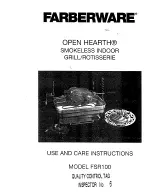
INSTALLATION
page 22
4.13 GUIDELINES FOR THE HYDRAULIC CONNECTIONS OF THE LE SERIES BOILERS
Remove the precut covers from the
exchanger holes on the side panels of the
outer casing; also remove the rectangular
precut cover from the left side panel (see
image on previous page) located on the
back of the panel: this opening is used for
the hydraulic connections to the
exchanger.
Remove the cover (3) and remove the
covers on the opposite side panel.
Insert the exchanger (1) and secure it to
the boiler using the screws and nuts provided (2).
Close the hole with the cover (3).
By installing the thermal relief valve the excess heat is absorbed as soon as the boiler,
for external reasons, rises to temperature values which are far too high. This function is referred to as fast
disconnection phase.
Whenever it is necessary the exchanger can be used to produce hot water for domestic use. This use of
the exchanger must not last too long an amount of time as otherwise the boiler will cool down too much.
Furthermore, the removal of the water must be simultaneous with the operation of the boiler.
Safety standards stipulate that solid fuel fired boilers can only be installed in plants with an open expansion
tank.
They must be equipped with:
a)
Open expansion tank
b)
Safety tube with suitable section
c)
Feed tube for water to refill the boiler
d)
Thermal safety relief valve
The safety tube (b) must be connected to the boiler delivery tube and no cutoff devices must be installed
on it. Its path from the boiler to the open expansion tank must be as short as possible and must never have
descending sections or sections with siphons.
The sensitive bulb of the thermal relief valve with capillaries must be inserted in the special pocket situated
under the boiler delivery tube.
The thermal relief valve disposes of the excess heat if there is an excessive increase in the temperature of
the water in the boiler.
If the boiler is fitted with a heat exchanger for the production of hot water for domestic use, the thermal
relief valve will have to be installed at its outlet. A safety valve calibrated at 6 bar must also be installed at
the heat exchanger outlet.
It is extremely important that the plant does not display any natural circulation phenomena as until the water
has a temperature below 55-60°C, the humidity contained in the smoke would condensate inside the boiler.
The condensation is acidic and consequently corrosive which is extremely damaging for the steel walls of
the boiler, especially those not protected by vitrification.
Therefore, plants with natural circulation must be fitted with a nonreturn valve downstream from each
circulating pump.
2
1
3
1
SAFETY EXCHANGER / HEAT EXCHANGER
2
SCREWS AND NUTS FOR FASTENING
EXCHANGER INLET-OUTLET
3
COVER
4.12
INSTALLATION OF SAFETY EXCHANGER / HEAT EXCHANGER ON ASPIROMEC LE
ASPIROTRONIC LE (OPTIONAL).











































